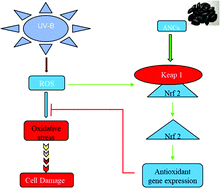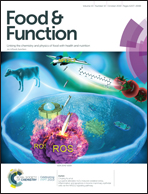Anthocyanins from black peanut skin protect against UV-B induced keratinocyte cell and skin oxidative damage through activating Nrf 2 signaling
Abstract
Excessive Ultraviolet (UV) irradiation induces skin damage. In the present study, the potential protective activity of anthocyanins (cyanidin-3-O-sophoroside and cyanidin-3-O-sambubioside) from black peanut against skin damage induced by UV-B was evaluated in vitro and in vivo. Treatment with anthocyanins significantly reversed UV-B induced oxidative damage and following apoptotic death in human HaCaT cells. Nuclear-factor-E2-related factor 2 (Nrf 2) was activated by anthocyanins through Nrf 2 protein stabilization and nuclear translocation, along with the expressions of antioxidant responsive element (ARE)- related genes (HO1, GCLC and NOQ1). Nrf 2 knockdown in HaCaT cells by targeted-shRNA plasmid markedly abolished the protective activity of anthocyanins against UV-B irradiation. Additionally, topical application of anthocyanins (5 mg cm−2) inhibited UV-B induced oxidative stress and cell apoptosis in BALB/c mouse skin tissues. The protective effect of anthocyanins can be explained by the regulation of oxidative-stress and the suppression of cell apoptosis through the activation of Nrf-2 by interaction with the MAPK and NF-κB signaling pathways. Our results suggested that anthocyanins from black peanut skin might be used as a potential photochemo-protective agent against UV-B induced skin damage.



 Please wait while we load your content...
Please wait while we load your content...